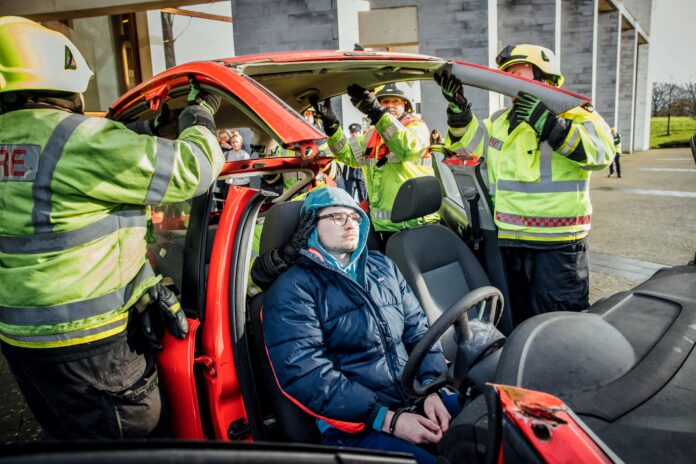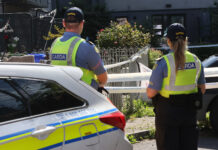
THE UNIVERSITY of Limerick (UL) was the scene of a major incident exercise that saw student paramedics, nurses, and doctors, alongside personnel from the emergency services, spring into action yesterday afternoon (Thursday, January 25). And it was all a well-choreographed act.
An immersive simulation was planned and carried out to help prepare UL students for a real-world multi-casualty major incident where a response is required from multiple agencies.
Members of Limerick Fire and Rescue Service, National Ambulance Service (NAS), the Explosive Ordnance Division (EOD) of the Irish Defence Forces (bomb squad), An Garda Siochána Armed Support Unit, and Limerick Civil Defence were also involved in the exhilarating operation.
One simulated scenario involved a car crashing into a group of people, trapping the driver in the car, while a passenger emerged towards the gathered crowd with a mock handgun and an explosive device.
The actor fired ‘shots’ at several bystanders before escaping to the River Shannon where he was picked up by Civil Defence’s Swift Water Rescue team and the Armed Support Unit.
Another passenger in the car wielded a machete and ‘injured’ a number of people.
The drill exercise took place on UL’s North Campus, where students were tasked with managing the scene and providing emergency assistance to those involved. There was a large number of people gathered in the incident area with various levels of injury and distress.
The students were aware that the exercise was happening ahead of time, to avoid triggering genuine shock, alarm, or trauma, but were not told ahead of time what exactly would unfold, so that they could react to the exercise as it was happening.
Frank Keane, senior clinical teaching fellow on the BSc in Paramedic Studies at UL ,said: “This exercise gave those involved a drill in preparing and responding to an evolving emergency situation, action manoeuvres across different disaster locations, handling multiple casualties, dealing with a crime scene, and implementing a swift-water rescue.”
“It gives the students the opportunity to gain exposure to life-changing situations. For the experienced professionals, it’s an opportunity to develop their skills under pressure.”
Professor Deirdre McGrath, interim executive dean of the Faculty of Education and Health Sciences, added: “The ability to collaborate and respond effectively to emergencies is a crucial skillset that benefits society as a whole.”
“Simulations such as we have seen today can be highly effective, allowing participants, irrespective of their discipline and level of experience, to apply their knowledge and skills in a realistic setting without the actual risks involved.”
Over 50 ‘casualties’ had to be triaged and treated by paramedics, as well as nursing and medical students, who also were tasked with erecting a field hospital.
The event culminated in the arrival of Irish Coast Guard Helicopter Rescue 115 where the students, who were all closely supervised, had the unique opportunity to practice loading a stretcher onto the helicopter while the rotor blades were turning.








